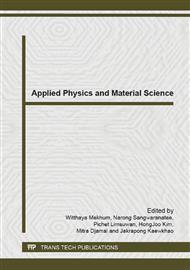p.124
p.128
p.132
p.135
p.139
p.143
p.147
p.151
p.155
Impact Modification of Wood Plastic Composite from Acrylate-Styrene-Acrylonitrile and Bagasse
Abstract:
The improvement in impact properties of wood plastic composite from acrylate-styrene-acrylonitrile (ASA) and bagasse was reported in this work. The effect of type and content of impact modifier by using styrene-butadiene-rubber (SBR) and ethylene-acrylic acid (EAA) as impact modifier on morphology and mechanical properties of wood plastic composite were investigated. Wood plastic composites, prepared from ASA and 50 phr of bagasse by varying amount of impact modifier (both SBR and EAA) from 0-40 wt% of ASA were prepared by melt-blending technique. All materials were mixed by using a two-roll-mill, shaped into sheets by a compression molding machine and specimens were cut with a cutting machine. Then, the obtained materials were characterized, including morphology, impact strength and flexural properties. From SEM micrographs showed that wood plastic composites with using SBR as impact modifier showed more compatible with ASA matrix than EAA. This is a consistency results with mechanical properties such as impact properties, which indicated that the impact strength was improved with increasing the amount of SBR from 0-40 wt% of ASA. However, wood plastic composite with EAA showed the reduction of impact strength. So, it could be demonstrated from this study that the most appropriate impact modifier for wood plastic composite from ASA and bagasse was styrene-butadiene-rubber.
Info:
Periodical:
Pages:
139-142
Citation:
Online since:
June 2014
Price:
Сopyright:
© 2014 Trans Tech Publications Ltd. All Rights Reserved
Share:
Citation:


